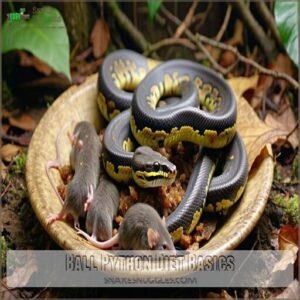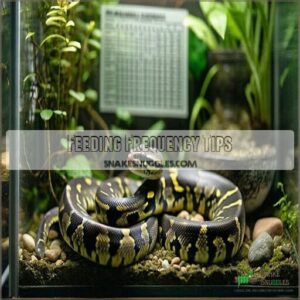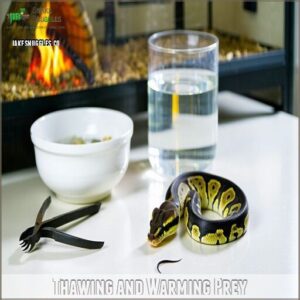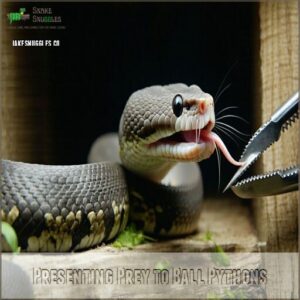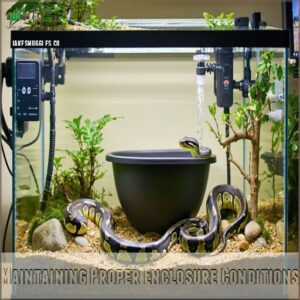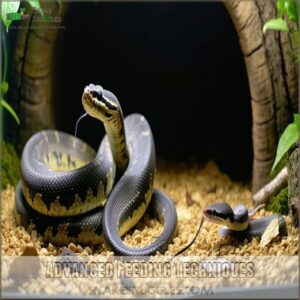This site is supported by our readers. We may earn a commission, at no cost to you, if you purchase through links.
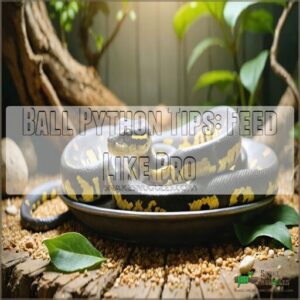
Match prey size to your snake’s girth and vary the food for balanced nutrition.
Feed hatchlings every 5-7 days, juveniles every 7-14 days, and adults every 10-21 days.
Thaw and warm prey safely, and use feeding tongs for safe handling.
By following these guidelines, you’ll be well on your way to becoming a pro at feeding your ball python – and there’s more to learn about creating a thriving environment for your pet.
Table Of Contents
- Key Takeaways
- Ball Python Diet Basics
- Prey Selection Guidelines
- Feeding Frequency Tips
- Prey Preparation Methods
- Safe Feeding Practices
- Ball Python Nutrition Needs
- Feeding Chart and Schedule
- Advanced Feeding Techniques
- Frequently Asked Questions (FAQs)
- How do I properly feed my ball python?
- Should you feed ball pythons in their cage?
- What is the best feeding schedule for ball pythons?
- Is it better to feed ball pythons at night or day?
- Can snakes accidentally swallow their own bedding while eating?
- Should I feed my python during or after shedding?
- What time of day is best for feeding?
- How long should I wait before handling after feeding?
- Conclusion
Key Takeaways
- You’ll want to feed your ball python appropriately-sized frozen-thawed rodents, matching their girth, and vary the food for balanced nutrition, so it’s essential to understand their carnivorous diet requirements.
- To establish a feeding schedule, you’ll adjust the frequency based on your snake’s age, feeding hatchlings every 5-7 days, juveniles every 7-14 days, and adults every 10-21 days, considering growth rates and nutrition needs.
- When preparing prey, you’ll thaw frozen mice or rats safely, warm them to body temperature, and use feeding tongs for safe handling, ensuring a stress-free feeding experience for your pet.
- You shouldn’t handle your ball python immediately after feeding, so it’s best to wait at least 24-48 hours to guarantee a safe and healthy digestion process, and you’ll also want to maintain proper enclosure conditions, including temperature control, humidity levels, and lighting options, to promote healthy feeding habits and overall well-being.
Ball Python Diet Basics
You’re about to learn the basics of feeding your ball python, and it’s necessary to understand their carnivorous diet requirements.
By following these guidelines, you’ll be able to provide your pet with a balanced diet that meets their nutritional needs, ensuring they stay healthy and thrive.
Carnivorous Diet Requirements
As a ball python owner, you’ll focus on a carnivorous diet, prioritizing prey quality and meat sources to meet their dietary needs.
Ensuring a balanced nutrient intake for ideal health, and maintaining food safety, are all essential for a well-planned ball python diet, focusing on balanced nutrient intake.
Prey Size and Variety
You’ll want to evaluate prey size and variety for your ball python’s diet.
Some key points to note:
- Prey options include frozen-thawed rodents
- Size guidelines match snake’s girth
- Feeding variety is important for snake nutrition
- Meal planning guarantees proper nutrition
Feeding Frequency and Age
You’ll adjust feeding frequency based on your snake’s age.
The feeding frequency varies by age:
| Age | Feeding Frequency |
|---|---|
| Hatchling | every 5-7 days |
| Juvenile | every 7-14 days |
| Adult | every 10-21 days |
Consider growth rates and nutrition needs. Ball pythons are obligate carnivores, so their dietary requirements consist of whole prey, which is a key factor in their diet.
Prey Selection Guidelines
You’re about to learn how to select the perfect prey for your ball python, and it’s vital to get it right.
By following these prey selection guidelines, you’ll be able to provide your pet with a nutritious and satisfying meal that meets its specific needs.
Choosing Prey Species
When selecting prey, consider variety, including rodent types like mice and rats, to maintain snake nutrition and prey quality.
Choosing between frozen-thawed rodents and live rodents for your feeding options is crucial, focusing on prey species suitable for your ball python’s needs.
Frozen rodents can be purchased from online retailers, which provides a convenient option for ball python owners to source frozen-thawed rodents.
Prey Size and Snake Girth
Now that you’ve chosen your prey species, let’s talk sizing. Matching prey size to your snake’s girth is key for a healthy, happy python. Think of it like Goldilocks—not too big, not too small, but just right.
Aim for a feeding ratio where the prey item is roughly the same thickness as the widest part of your snake’s body.
To achieve this, consider the following measurements:
- Prey Measurement: Use a ruler or caliper.
- Snake Girth: Measure at the thickest point.
- Feeding Ratio: 1:1 prey to girth ratio.
- Prey Scaling: Increase size as your snake grows.
For more specific guidance, consult a feeding chart for your ball python’s age and weight. This helps guarantee appropriate python prey size and feeding size. Understanding the correct prey size guidelines is essential for the snake’s health.
Live or Frozen-Thawed Prey
You’ll weigh the pros and cons of live versus frozen-thawed prey, considering Prey Safety and Live Prey Risks, to make an informed decision.
Opting for Frozen Options like thawing frozen mice for a stress-free feeding experience with frozenthawed rodents.
Feeding Frequency Tips
You’ll want to establish a feeding schedule that meets your ball python’s needs, which vary by age and size.
As you evaluate the right feeding frequency, you’ll need to take into account factors like your snake’s growth stage, weight, and overall health to provide the best possible care.
Hatchling Feeding Schedule
You’re feeding hatchlings, focusing on their diet.
Here are key points:
- Feed every 5-7 days
- Monitor weight gain
- Adjust meal frequency
- Assure proper snake growth
- Follow a feeding schedule for your baby ball python.
Understanding the proper snake feeding schedule is critical for their development.
Juvenile and Adult Feeding Frequency
As your ball python grows, you’ll adjust feeding schedules.
Juvenile ball pythons eat every 7-10 days, while adults eat every 2-3 weeks, depending on growth rates and snake weight.
Affecting meal frequency and feeding cycles in ball python feeding is crucial, as it depends on these factors.
Breeding Female Feeding Adjustments
When managing breeding female ball pythons, consider:
- Breeding Nutrition
- Female Supplements
- Pregnancy Diet
- Egg Production
to adjust their feeding schedule, prey size, and nutrition for best health and egg production, ensuring a balanced diet during lactation needs.
Prey Preparation Methods
You’re about to learn the best ways to prepare prey for your ball python, and it’s easier than you think.
By following these simple steps, you’ll be able to thaw, warm, and present prey to your snake like a pro.
Ensuring a healthy and happy pet is the ultimate goal, and this can be achieved by properly preparing the prey for your ball python.
Thawing and Warming Prey
When preparing prey, you’ll want to thaw frozen mice or rats safely.
You can purchase frozen mice for snakes online.
Thawing methods involve refrigeration or cold water, and warming techniques, like gentle heat, help stimulate feeding.
Handle prekilled rodents with care, using feeding tongs for safe handling of frozen-thawed prey to prevent injury.
Using Feeding Tongs and Hemostats
You’ll use feeding tongs or a hemostat to grip prey, ensuring feeding safety and proper snake presentation.
Using tongs offers significant safety and hygiene benefits.
Mastering tong handling and prey grip is key to successful feeding techniques, making the feeding process efficient and stress-free for both you and your ball python.
Presenting Prey to Ball Pythons
Now that you’ve got your feeding tongs ready, it’s time to present that tasty treat to your pet python.
Go ahead and grip the prey firmly with those tongs—you don’t want to drop it mid-offer! Gently wiggle the prey to stimulate your snake’s strike response. They might be shy at first, but a little movement can spark their hunting instinct.
Remember:
- Snake’s instinct: Stimulate their natural hunting drive.
- Gentle movements: Avoid sudden, aggressive motions.
- Patience pays: Give your snake time to strike.
- Safety first: Tongs keep your fingers safe.
Safe Feeding Practices
You’re about to learn the best practices for feeding your ball python, and it’s important to get it right to make sure your pet’s health and well-being are maintained.
By following safe feeding practices, you’ll be able to provide your ball python with the nutrition it needs to thrive.
Avoiding Overfeeding and Underfeeding
To make sure of the best feeding, monitor your snake’s weight and adjust the feeding frequency accordingly, avoiding overfeeding and underfeeding, which can hinder healthy growth and best nutrition.
So pay attention to feeding cues to maintain a balanced feeding schedule for your ball python’s overall snake nutrition and well-being always, ensuring healthy growth.
Maintaining Proper Enclosure Conditions
Maintain a stable environment with proper temperature control, humidity levels, and lighting options in your ball python’s enclosure.
This includes a large water bowl and suitable substrate, to promote healthy feeding habits and overall well-being.
Considering enclosure size and ventilation systems is crucial for ideal humidity and temperature, which directly affects the overall well-being of the ball python.
Reducing Stress and Handling
Minimize handling, especially after feeding. A gentle touch is key for snake calming.
To reduce stress and encourage feeding, consider these handling techniques:
- Handle less frequently.
- Avoid handling after feeding.
- Use a gentle touch.
- Provide ample hides.
- Keep the enclosure in a quiet area.
Less stress means a happier snake, and a happy snake is more likely to eat. If your snake is refusing food, stress reduction through minimal handling may be a helpful feeding tip.
Ball Python Nutrition Needs
You’ll want to understand your ball python’s nutritional needs to make sure they’re getting the best possible care.
By knowing what to feed your ball python and how often, you can help them thrive and maintain a healthy weight, which is important for their overall well-being.
Supplementing With Vitamins and Minerals
You’re considering vitamin needs for your ball python.
You can purchase ball python vitamin supplements.
| Vitamin | Mineral | Calcium |
|---|---|---|
| D3 | phosphorus | 1-2% |
| A | calcium | 1-3% |
| E | potassium | 0.5-1% |
Use supplements sparingly, focusing on calcium boost and nutrient balance.
UVB Lighting and Calcium Requirements
You’ll want to explore UVB lighting for your ball python’s calcium needs and vitamin D3 production, a key part of effective ball python nutrition.
As it aids in calcium absorption and strong bone development, offering various UVB benefits through proper lighting options and potentially mineral supplements, UVB lighting is crucial for calcium absorption.
Avoiding Inappropriate Food Items
When feeding your ball python, beware of toxic foods like wild prey, fish products, and insect meals.
Avoid raw eggs and opt for frozen-thawed mice over live rodents for safe prey selection, considering prey size, prey species, and nutritional needs to maintain a healthy diet.
Feeding Chart and Schedule
You’ll create a personalized feeding chart and schedule for your ball python, taking into account its age, weight, and individual needs.
By following these guidelines, you’ll be able to provide your pet with a balanced and nutritious diet, ensuring it stays healthy and thrives under your care.
Creating a Feeding Chart
Create a ball python feeding chart to track feeding intervals, snake growth, and prey ratios.
| Age | Weight | Prey Size |
|---|---|---|
| Hatchling | 50g | Small |
| Juvenile | 100g | Medium |
| Sub-adult | 200g | Large |
Monitor weight tracking and feeding cycles. Understanding a proper snake feeding schedule is important for the health of your ball python.
Adjusting Feeding Schedules for Age
As you’ve created a feeding chart, now adjust schedules based on age.
The adjustment of schedules is crucial for the different stages of development, which include: Hatchling, Juvenile, Sub-adult, and Adult.
| Age | Feeding Frequency |
|---|---|
| Hatchling | every 5-7 days |
| Juvenile | every 7-10 days |
| Sub-adult | every 10-14 days |
| Adult | every 2-3 weeks |
Monitoring Weight and Adjusting Feedings
Monitor your ball python’s weight regularly to adjust feedings.
The weight of your ball python is crucial in determining the right feeding schedule, with key milestones including hatchling, juvenile, sub-adult, and adult stages.
| Age | Weight | Feed Adjustment |
|---|---|---|
| Hatchling | 50g | Increase feed frequency |
| Juvenile | 100g | Maintain frequency |
| Sub-adult | 200g | Decrease frequency |
| Adult | 500g | Adjust prey size |
| Breeding | varies | Consult expert |
Advanced Feeding Techniques
You’re taking your ball python care to the next level by exploring advanced feeding techniques.
By mastering these tips, you’ll be able to move your snake to new prey types, encourage picky eaters to feed, and manage feeding refusals and health issues with confidence.
Transitioning to New Prey Types
When switching prey, consider:
- Prey scenting
- Gradual introduction
- Snake preferences
- Prey size to avoid food refusal and guarantee a smooth prey shift, especially when switching from mice to rats or from live to frozen.
Safe snake feeding techniques are essential for healthy snakes.
Encouraging Picky Eaters to Feed
To encourage picky eaters, try varying prey selection and using feeding tricks like scenting thawed rodents with blood.
Offer multicolored or brown rodents to stimulate appetite, and consider live prey for reluctant eaters.
While avoiding feeding mistakes and focusing on prey variety to address feeding problems.
Managing Feeding Refusals and Health Issues
You’ll encounter feeding refusals, so identify refusal reasons and perform health checks.
Use feeding aids to stimulate appetite, understanding snake behavior.
Refusal solutions include adjusting prey, reducing stress, and addressing snake health issues, especially regurgitation, to help reluctant eaters.
Frequently Asked Questions (FAQs)
How do I properly feed my ball python?
Feed your ball python appropriately-sized frozen-thawed rodents every 1-3 weeks based on age. Use feeding tongs, warm prey to body temperature, and don’t handle your snake immediately after meals.
Should you feed ball pythons in their cage?
Like a creature in its natural den, your ball python feels safest eating in its enclosure. You’ll minimize stress and avoid regurgitation by letting them dine in their familiar habitat.
What is the best feeding schedule for ball pythons?
You’ll want to schedule meals every 5-7 days for young pythons, progressing to 10-14 days for sub-adults.
Adult ball pythons typically eat every 2-3 weeks, with prey size matching their body width.
Is it better to feed ball pythons at night or day?
You’ll get better results feeding your ball python at night since they’re nocturnal hunters.
They’re naturally more alert and ready to eat when it’s dark, just like they’d be in the wild.
Can snakes accidentally swallow their own bedding while eating?
Just as a vacuum cleaner picks up unwanted debris, your snake can accidentally ingest substrate while eating.
You’ll want to feed your ball python on a clean, flat surface to prevent accidental substrate consumption.
Should I feed my python during or after shedding?
You shouldn’t feed your ball python during shedding since they’re less interested in food and more vulnerable.
Wait until 2-3 days after they’ve completed their shed when they’ll be hungry and ready.
What time of day is best for feeding?
Since ball pythons are nocturnal, you’ll have the most success offering meals in the evening or at night.
Your snake’s natural hunting instincts kick in after dark, making feeding more effective.
How long should I wait before handling after feeding?
Should wait at least 24-48 hours before handling your ball python after feeding to guarantee a safe and healthy digestion process.
Conclusion
Fearlessly feeding your ball python becomes effortless with practice.
By following these expert tips for feeding ball pythons, you’ll master the art of mealtime, ensuring a healthy, happy pet.
Perfectly pairing prey size and type with your snake’s needs is key to a thriving environment, making you a pro at providing the best tips for feeding ball pythons, and this is the key to mastering the art of feeding your pet.
- https://reptifiles.com/ball-python-care-guide/ball-python-feeding/
- https://www.webmd.com/pets/feeding-a-ball-python
- https://www.reddit.com/r/ballpython/comments/t4a9b9/getting_a_ball_python_to_eatsuggestions/
- https://aminoapps.com/c/reptiles/page/item/feeding-tips-for-tricky-ball-pytons/vd1W_1bjsWIwEDR5wxrpeW6WQnd4pr6xbXk
- https://news.uark.edu/articles/10141/how-snakes-survive-starvation

